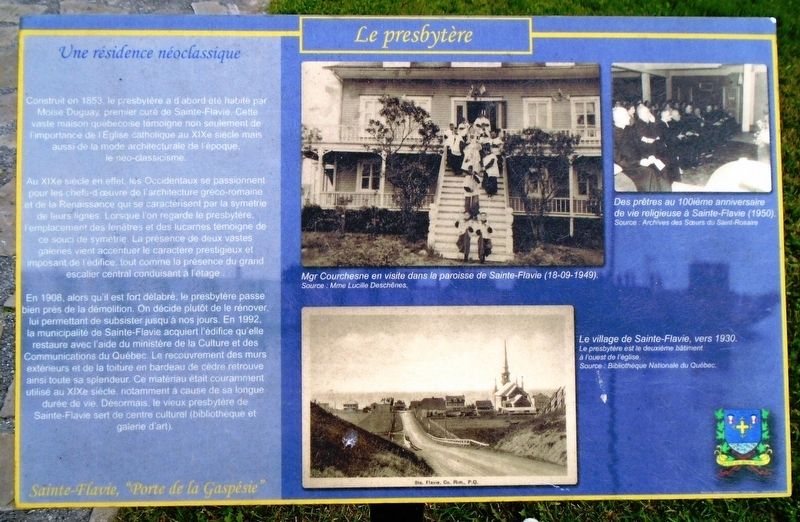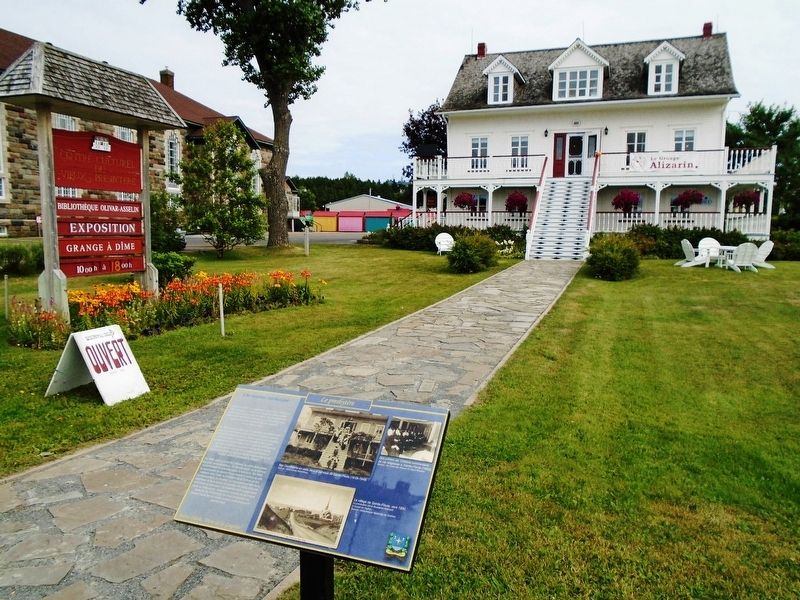Le presbytère / The Rectory
Sainte-Flavie, "Porte de la Gaspésie"
Construit en 1853, le presbytère a d'abord été habité par Moïse Duguay, premier curé de Sainte-Flavie. Cette vaste maison québécoise témoigne non seulement de l'importance de l'Église catholique au XIXe siècle mais aussi de la mode architecturale de l'époque, le néo-classicisme.
Au XIXe siècle en effet, les Occidentaux se passionnent pour les chefs-d'œuvre de l'architecture gréco-romaine et de la Renaissance qui se caractérisent par la symétrie de leurs lignes. Lorsque l'on regarde le presbytère, l'emplacement des fenêtres et des lucarnes témoigne de ce souci de symétrie. La présence de deux vastes galeries vient accentuer le caractère prestigieux et imposant de l'édifice, tout comme la présence du grand escalier central conduisant à l'étage.
En 1908, alors qu'il est fort délabré, le presbytère passe bien près de la démolition. On décide plutôt de le rénover, lui permettant de subsister jusqu'à nos jours. En 1992, la municipalité de Sainte-Flavie acquiert l'édifice qu'elle restaure avec l'aide du ministère de la Culture et des Communications du Québec. Le recouvrement des murs
extérieurs et de la toiture en bardeau de cèdre retrouve ainsi toute sa splendeur. Ce matériau était couramment utilisé au XIXe siècle, notamment à cause de sa longue durée de vie. Désormais, le vieux presbytère de Sainte-Flavie sert de centre culturel (bibliothéque et galerie d'art).• Mgr Courchesne en visite dans la paroisse de Sainte-Flavie (18-09-1949).
• Des prêtres au 100ième anniversaire de vie religieuse à Sainte-Flaview (1950).
• Le village de Sainte-Flavie, vers 1930.
Built in 1853, the rectory was first inhabited by Moses Duguay, first priest of Sainte-Flavie. This vast Quebecois house testifies not only to the importance of the Catholic Church in the nineteenth century but also to the architectural fashion of the time: neo-classicism.
In the nineteenth century, Westerners were passionate about the masterpieces of Greco-Roman and Renaissance architecture that are characterized by the symmetry of their lines. When looking at the rectory, the location of windows and skylights testifies to this concern for symmetry. The presence of two large galleries accentuates the prestigious and imposing character of the building, as does the presence of the grand
In 1908, while very dilapidated, the rectory nearly fell to demolition. Locals decided instead to renovate it, allowing it to survive until today. In 1992, the municipality of Sainte-Flavie acquired the building that it restored with the help of the Quebec Ministry of Culture and Communications. The exterior walls and the cedar shingle roof are in full splendor. Cedar was commonly used in the nineteenth century, especially because of its long life. Today, the old Sainte-Flavie rectory serves as a cultural center (library and art gallery).
• Priests at the 100th anniversary of Sainte-Flavie religious life (1950).
• The village of Sainte-Flavie, around 1930.
• Bishop Courchesne visiting the parish of Sainte-Flavie (18-09-1949).
Erected by Municipalité de Sainte-Flavie.
Topics. This historical marker is listed in these topic lists: Architecture • Churches & Religion • Entertainment. A significant historical year for this entry is 1853.
Location. 48° 36.662′ N, 68° 13.788′ W. Marker is in Sainte-Flavie, Québec, in La Mitis. Marker is at the intersection of route de la Mer (Québec Route 132) and route Flavie-Drapeau, on the right when traveling north on route de la Mer. Touch for map.
Other nearby markers. At least 8 other markers are within 8 kilometers of this marker, measured as the crow flies. La maison du bedeau / The Sexton's House (within shouting distance of this marker); L'église de Sainte-Flavie Church (within shouting distance of this marker); La Vielle Auberge / The Old Inn (within shouting distance of this marker); La grange à dîme / The Tithe Barn (within shouting distance of this marker); Le magasin général / The General Store (within shouting distance of this marker); La maison Langlois (about 90 meters away, measured in a direct line); Place Clément-Chouinard Plaza (approx. half a kilometer away); Les Jardins de Métis (approx. 7.7 kilometers away). Touch for a list and map of all markers in Sainte-Flavie.
Also see . . .
1. Un peu d'histoire sur Sainte-Flavie. (Submitted on January 22, 2019, by William Fischer, Jr. of Scranton, Pennsylvania.)
2. Eglise de Sainte-Flavie. (Submitted on January 22, 2019, by William Fischer, Jr. of Scranton, Pennsylvania.)
3. Sainte-Flavie. (Submitted on January 22, 2019, by William Fischer, Jr. of Scranton, Pennsylvania.)
Additional keywords. Le presbytère / The Rectory
Credits. This page was last revised on January 20, 2020. It was originally submitted on January 22, 2019, by William Fischer, Jr. of Scranton, Pennsylvania. This page has been viewed 113 times since then and 12 times this year. Photos: 1, 2. submitted on January 22, 2019, by William Fischer, Jr. of Scranton, Pennsylvania.

